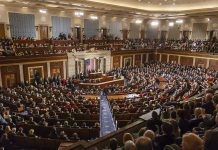
President Trump’s decisive move to end major U.S. sanctions on Syria marks a stark departure from previous administrations’ policies, potentially reshaping Middle Eastern dynamics while still holding accountable those responsible for human rights abuses.
Key Takeaways
- President Trump signed an executive order terminating many U.S. economic sanctions on Syria while maintaining restrictions on individuals involved in human rights abuses.
- The order lifts a national emergency declared by President George W. Bush and five related orders, aimed at reintegrating Syria into the global financial system.
- This policy shift follows Syria’s governmental change, with Trump meeting Interim President Ahmed al-Sharaa in May after the overthrow of Bashar al-Assad in December 2024.
- Major sanctions under the Caesar Act targeting Syria’s military and intelligence remain in place, with temporary waivers.
- The administration is reviewing Syria’s designation as a state sponsor of terrorism and HTS’s designation as a foreign terrorist organization.
Trump Delivers on Promise to Promote Peace in Syria
President Trump’s executive order lifting significant economic sanctions on Syria fulfills his commitment to foster stability in the region while maintaining accountability measures. The order specifically ends a national emergency declared by President George W. Bush along with five other related orders that have restricted Syria’s participation in the global economy. This strategic move aims to “promote and support the country’s path to stability and peace,” according to White House Press Secretary Karoline Leavitt.
“This is another promise made and promise kept to promote peace and stability in the region,” said White House Press Secretary Karoline Leavitt.
The sanctions relief comes after significant political changes in Syria, where Hayat Tahrir al-Sham (HTS) overthrew former President Bashar al-Assad in December 2024, establishing a new government under Interim President Ahmed al-Sharaa. President Trump met with al-Sharaa in May, signaling improved relations with Syria’s new leadership, which is considered more pro-Western than the previous regime. This meeting laid the groundwork for the current policy shift.
Balanced Approach to Sanctions Relief
While the executive order removes broad economic restrictions, it maintains targeted sanctions against individuals involved in human rights abuses and illegal activities, including former President Assad. This nuanced approach demonstrates the administration’s commitment to holding accountable those responsible for atrocities while allowing the Syrian people and economy to recover. The Treasury Department clarified that sanctions on terrorist groups and manufacturers of the drug Captagon will remain firmly in place.
“This is an effort to promote and support the country’s path to stability and peace,” said White House Press Secretary Karoline Leavitt.
The administration’s approach aligns with similar moves by European allies, as the European Union has also lifted nearly all remaining sanctions on Syria. This coordinated international approach suggests a broader recognition that economic engagement may be more effective than isolation in promoting regional stability. Treasury Department officials emphasized that the order will “end the country’s isolation from the international financial system, setting the stage for global commerce and galvanizing investments from its neighbors in the region, as well as from the United States,” according to Brad Smith.
Ongoing Security Considerations
Despite the significant sanctions relief, several important security measures remain in place. Major sanctions under the Caesar Act targeting Syria’s military and intelligence services continue, though with temporary waivers. Additionally, Syria is still designated as a state sponsor of terrorism, and the group led by Interim President al-Sharaa is currently considered a foreign terrorist organization. The State Department is actively reviewing these designations as part of a comprehensive reassessment of U.S.-Syria relations.
The U.S. has maintained a military presence in Syria since 2014, primarily focused on combating the Islamic State. This presence continues as the administration evaluates the security situation under the new Syrian leadership. Concerns about the treatment of minorities under the new government persist, highlighting the complex balancing act of promoting stability while upholding human rights principles. The administration is reportedly considering including Syria in the Abraham Accords, potentially further integrating the nation into regional peace initiatives.
This policy shift represents a significant departure from years of isolation imposed on Syria during its civil war, which began in 2011 and involved numerous international powers. By lifting these sanctions while maintaining targeted restrictions, President Trump’s administration has demonstrated a pragmatic approach to foreign policy that prioritizes regional stability while preserving accountability mechanisms for those responsible for atrocities.


















